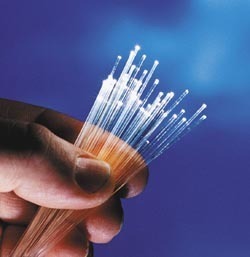FiOS
FiOS is a special type of data network that is offered to Fiber Optic Subscribers. The existing FiOS network is at a industry high where speed is concerned, as it offers 150 Megabits/second downloads with as much as 35 Megabits/second upload. The speeds of up to 50 Megabits/ second are offered to consumers at very high prices. 25 and 15 Megabits/second are lower options, yet they are still faster than the fastest lines available with other technologies.
The fiber optic networks that are currently in place are not yet fully functional and the speed that subscribers get will really depend on their distance from the provider and how much the FiOS lines bend throughout the trip. The light being transferred through the FiOS networks are actually lasers with high accuracy and low loss information carrying strength. Provided that the FiOS has the capability, this information will travel 186000 miles/second or less. So if the servers can process at such high speeds while connected to the FiOS network, files will transfer instantaneously, without any download delay. Even massive files that exceeded gigabytes would take mere seconds to transfer.
How FiOS Works
FiOS network’s ability to produce such speeds is simple yet significant. A fiber optic cable that is composed of hundreds of hair like strands of glass is used. These strands are designed to transmit information like a pulse of light. The Internet and phone providers’ hardware decodes the information that is encoded in the pulse of light that the lasers send.
Business FiOS Access Expands to Home FiOS
Businesses have had access to limited fiber optic technology for years, but home access to FiOS is growing. Lines are being laid in rural locations even though they may not be used for decades. As a result, homes now have access to high speed and high quality FiOS connections.
What FiOS Means to Customers
The Internet is mostly used for web surfing. Downloading/uploading videos, movies, music, and pictures is really only possible with the right amount of bandwidth and speed. Those who gain FiOS access will experience much faster speeds than they would have ever thought possible at a price similar to their current Internet price. Traditional cable is somewhat slow in comparison to the speeds that FiOS makes possible.
Fiber Optic network growth is a slow process and access to it is still restricted to the location where it is available. Network structure and hardware availability determine the kind of services that will be available to customers who are awaiting coverage in their area. FiOS will more likely be available in large, centralized cities rather than in rural townships.
FiOS services will not be confined to the Internet alone. Email service, website hosting, and phone service make it very attractive to customers. The cost of FiOS plans will certainly be higher, but as the technology cheapens, so will service costs.
FiOS Technology
Although the technology required to have the service is already well spread out, only 10 million people can subscribe to the service at home. The increase in web traffic and the need for bandwidth resources and fast connection really make FiOS investment safe, at least for the next few decades. Until new technology that surpasses FiOS capabilities is created, FiOS will remain on top.
There are roughly 35 companies that offer FiOS connection. Internet and cable are offered independently or as a package. Computers that have the appropriate operating systems can access these high speeds with the help of the specialized hardware in place. The service level offered determines the speeds and capabilities of the FiOS connections.
Copper coaxial cable is a reliable option for slower speeds, but the quality of the service decreases the farther the line goes. Fiber Optic lines can go much farther without disrupting the high speed connection. Fiber optic lines are designed with specialized fibers that can bend and twist but still carry the signal to its destination without a large loss in connection quality. Since light travels fast it offers high speeds and connections that are currently unmatchable.
The technology is advanced enough to connect a digital television line, a digital phone line, and the Internet through the same FiOS lines to millions of homes. The amount of information that has passed through other connection bandwidth in recent years will pass through these massive networks within a day. Network growth from that point will simply contribute to a much larger and higher capacity network.
FiOS Service Plan Options
Companies like Verizon are already installing the service with primary computers accessing the network at no additional cost. The installation fee, month to month agreement, and charges for additional computers and devices makes the service much more expensive than it needs to be. Special wiring is needed to run the fiber optic line into the home as well. The cost of the equipment, the power supply unit, and the battery backup unit for the service really increases overall costs. Consumers will more than likely increase Internet/television/telephone use due to the increase in resources available to them that were unavailable before. The secure network also provides adequate protection.


Comments - No Responses to “FiOS”
Sorry but comments are closed at this time.